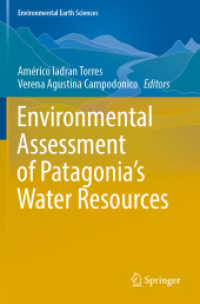- ホーム
- > 洋書
- > ドイツ書
- > Social Sciences, Jurisprudence & Economy
- > Education Science / Pedagogic
- > didactics, methodics, school education
Full Description
This volume discusses theory, philosophy, praxis and methods in Environmental and Ecological education, and considers the junction with the main visions and issues of Critical Pedagogy. The volume and its separate chapters address four axes, which can also be seen as the guidelines of the content as well as the central objectives of the book.
The first axis concerns the missing theoretical and practical pieces at this point in time. The volume considers the issues that are not included in contemporary Environmental Education, and thus, deprive it from critical orientations. This implies that in Environmental Education, very little discussion exists about the political, economic, racial, gender and class issues that in most cases govern the actions of leaders and stake-holders. The second axis concerns what has been done so far and in what directions. This involves descriptions of theoretical approaches or actual applied methodologies in the classroom, such as curriculaor syllabus used or the kind of actions certain educators have taken to infuse the issues of justice and critical reflection within the Environmental Education teaching agenda. The third axis examines proposals. It looks at ways to enrich domains of Environmental Education with the argumentations of Critical Pedagogy. The fourth axis concerns the way in which proposals can be effectuated. This part contains specific methodologies and teaching sequences, depicting ways of including major aspects of Critical Pedagogy and Critical Education in Environmental Education. Examples are: Non-anthropocentric ecological approaches in the classroom, political activism in the Curricula, mixture of field activities and political activities.
Contents
Foreword.- Our Human-Centered Focus is Killing Us (A case for returning to our original notion of diversity).- Hell: Critical Environmental Pedagogy through Popular Dystopic Films.- Finding an Environmentally Sustainable Future through Indigenous Hip Hop Culture.- Why Class Matters in Environmental Education.- "This Branch is an E": Duoethnographic Conversations between an Educator and a Parent.- Toward an Interspecies Critical Food Systems Education.- Ecocritical Environmental Education: Pedagogy for Resisting Human-Supremacy.- "Paulo Freire and a Curriculum for the Capitalocene.".- Critical situated learning and environmental education.- Critical Environmental Education with an ecosocialist vision or Natural Disasters taught as Socially-driven and Class-oriented phenomena: The point of view of Critical Pedagogy.- Integrating struggles for Environmental Justice into the Curriculum: A Critical Pedagogy viewpoint (* Three case-studies from Greece: Keratea's sanitary landfill, Chalkidiki's gold mines and the struggle regarding Asopos river).- Critical situated learning and environmental education.- "There is only the We": Education for Environmental Equity and Justice.- Creating Environments for Equity, Race, and Disciplinary Ideologies in Urban Teacher Education.








